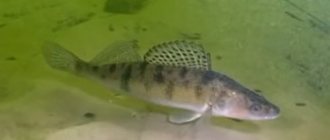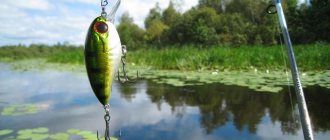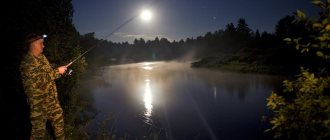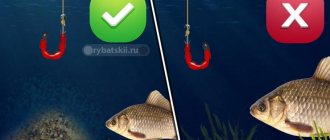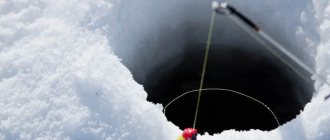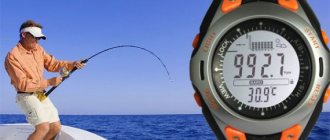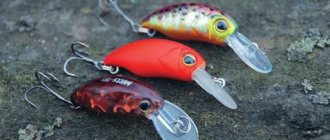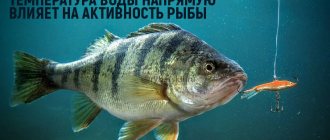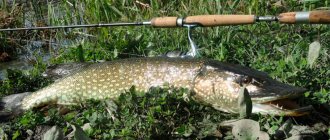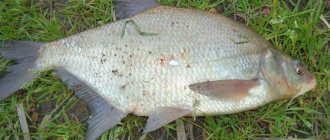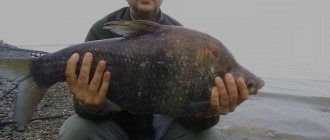Age
Spawning of bream begins when females reach a size of 30 centimeters; males of the same age can be 5-7 centimeters shorter; this difference in size is characteristic of almost all representatives of the ichthyofauna.
Moreover, the initial age of spawning individuals, depending on living conditions, ranges from three to five years.
Before spawning, bream are divided into age groups, so, for example, five-year-old males rub with a five-year-old female, and seven-year-old males rub with a seven-year-old female.
Time and temperature
The time when bream spawning begins depends on the water temperature and therefore varies depending on the region. If in the south of our country in the Volga basin spawning begins in mid-April, then closer to the north the timing shifts towards late spring. In the middle zone this is the beginning of May, in northern latitudes it is the middle of the month.
In any case, bream spawning begins when the water warms up to 12-15 degrees Celsius. Three-year-old breams begin to spawn first, after which their older brothers take turns spawning.
Each age flock spawns for several days, usually 3-4, after which it migrates to places familiar to its usual summer habitat.
Appearance
Bream is a ray-finned freshwater fish in which the notochord (a long axial cord) is replaced by a bony spine during growth. This class of fish received its name due to the peculiar structure of paired fins, in which there is no central axis. Belongs to the carp family and the order Cyprinidae. The bream is the only representative of the bream genus of the same name.
The upper jaw is movably connected to the skull, the dorsal fin is 1. Buoyancy is provided by the swim bladder, which is connected to the inner ear using the Weberian apparatus. With its help, the fish senses changes in the volume of the bubble and regulates its depth of immersion or the speed of ascent to the surface of the reservoir.
Bream has a unique gill arch structure. The gill rakers on the arch are arranged in 2 rows and one row has a muscle at the end that bends it to the side. This regulates the size of ingested food, which is not available to most inhabitants of the reservoir. Therefore, it easily displaces its relatives, such as roach and silver bream, from its habitat.
Rapid growth in the 3rd year of life removes the fish from the threat of predators - pike and catfish.
Chebak is a cautious and intelligent fish, which is why fishermen so rarely boast of a large trophy catch.
The bream fish is easily recognizable due to its unique morphological structure. Her body is compressed from the sides, thanks to this she easily avoids nets and seines, lying on the bottom of the reservoir sideways in small depressions. The older the fish, the harder it is to catch.
The head, eyes and mouth are small, behind the head the back rises sharply upward, forming a hump in adult fish. The body shape is round, raised high and the height to length ratio reaches 1:3.
The upper lip is broken in the middle and slightly bent down; when water is drawn in, it forms a proboscis. With its help, the fish can easily remove small mollusks and molted crayfish from their hiding places.
Thanks to this arrangement of gills, it quickly becomes dominant in the reservoir and survives smaller competitors, such as silver bream and crucian carp.
The dorsal fin, which serves to hold the fish's body in an upright position and with the help of which it is possible to avoid rotation around its axis, is short and tall in the bream. The first three rays are hard and unbranched, and the bream has up to 10 soft and branched rays.
The anal fin has three hard and up to 29 soft rays. It is long and its beginning is located under the end of the dorsal fin.
The keel of the fish is located between the ventral paired fins and the anal fins and is not covered with scales.
The pharyngeal teeth are located in the mouth; they are small, single-rowed, five in number, on the right and left sides of the lower lip.
The bream has a paired pectoral fin and no adipose fin.
Its caudal fin is homocercal, has two unequal blades, clearly defined semicircular, diverging at an angle of 60. The photo shows that the upper ray is much shorter than the lower one.
The pelvic, pectoral and anal fins are slightly pinkish in color, the rest are dark gray.
In adults, the back is gray or brown, the underbelly and sides are golden. Young breams have silvery scales. The scales on the lateral line of the fish’s body number from 49 (breeder) to 60 in adult fish.
Preparation
Despite the fact that bream spawning does not begin before mid-April, the fish begins to prepare for the most crucial moment of its life while still under the ice. Preparation for spawning is divided into several stages:
- Awakening. When spring waters begin to flow under the ice, bream begin to rise from the holes, feed and prepare to move to the spawning ground.
- Path. The beginning of ice drift coincides with the movement of bream schools to future spawning grounds. Often this path, which the fish travels against the current, is several kilometers long. During this period, bream actively feed, greedily grabbing everything that melt water brought into the river.
- Arrival. By the time the flock reaches the spawning area, the required water temperature has been established there.
Place
Bream spawning occurs mainly in shallow water. In such places under water there must be last year's aquatic vegetation or small snags. These can be shallow river bays, meadows flooded with melt water. Often schools of bream enter small rivers that flow into their native river to spawn.
The water temperature in the shallow spawning grounds at the time the flock arrives here is already significantly warmed up by the spring sun and reaches the required 12 degrees, which means mating games can begin.
Process
Before breeding begins, individuals ready for the process begin to darken, and males also become covered with warts.
Usually flocks, separated by age, flock together in the evening and begin to rub their sides, jump out of the water, falling flat. The noise of spawning bream can be heard at a great distance. Spawning occurs throughout the night and at dawn, and stops with the onset of daylight.
If the weather is calm and sunny, the whole process can be completed in a day; in less good weather it can last 3-4 days.
When it gets colder, females stop spawning and go deeper. If the weather is unfavorable for spawning, it loses its properties and spawning may not end. Unspawned eggs sometimes lead to the death of females.
Where to catch bream
This species of carp is a schooling fish. The size of flocks can reach several hundred individuals of approximately similar size. The larger the fish, the smaller the school number. Based on these characteristics of their habitat, fish gathered in schools need large water areas with opportunities for parking and feeding areas for fish. The flocks' sites are located in parts of the reservoir remote from the shore with moderate or quiet currents and depths of three meters. Extensive holes in which water flows are slowed down by the relief structures of the bottom are ideal base points for schools of bream, which love constancy, sedentism and migrate short distances only for feeding and spawning.
You can catch bream only on the way to the place of searching for food or directly at the feeding point. Consequently, the angler’s knowledge of the school’s movement paths is one of the foundations for successful fishing. As a rule, selected bottom plateaus with a silt layer are located at distances of up to a couple of hundred meters from the school’s parking areas. These bottom plains are associated with smooth rises to the coastlines and form shallow backwaters, fenced with thickets of reed and reed fields, where schools of bream graze, obtaining their food by digging in the silt deposits.
Clay and sand shallows inhabited by mollusk colonies will also be places of pilgrimage for schools, and the presence of a wall of coastal vegetation will only increase the chances of a promising bream point. All of the above listed signs of places suitable for fishing in most cases will require the fisherman to have a swimming device that will help to fish the selected point more effectively, and will also make it possible to get a decent distance from the shore to a remote part of the river or lake.
It is with great regret that we have to admit that in our time, catching bream from the shore is becoming a rare pleasure, due to the reduction of suitable places for fish to stay due to increased human activity, forcing bream to look for more secluded and quiet habitats away from the coastlines.
After spawning
For some time after spawning, the bream school remains in place, where it regains its strength and feeds heavily. The zhor lasts 3-4 days, only then, having regained some strength, it goes downstream to its usual habitats.
During this time, small breams already hatch from the fertilized eggs. If the weather is favorable, the incubation period of the eggs lasts from a week to twelve days.
Small breams begin to feed and by the age of one month can gain up to 70 grams of weight.
What does bream fish look like?
Bream fish is one of the most famous representatives of its genus, which includes such fish as silver bream, syrty, klepets and bluefish. All these fish have a compressed, flat body and blackish fins. They have a high and narrow dorsal fin, the anal fin is very long with 29 rays, which serves as a keel and gives good lateral stability; the upper lobe of the caudal fin is noticeably shorter than the lower lobe. And also in all these fish, from the back of the head to the dorsal fin, a groove with small scales stretches, and between the anal and ventral fins, the belly forms a sharp, leathery rib.
The bream's head looks small and its mouth is small, but at the same time, in order to feed and eat various food from the bottom, the lips are extended in the form of a small trunk to suck in food, worms or larvae living on the bottom.
Small representatives are usually called white breams, but their body is narrower and more elongated than that of large individuals, and they have relatively large eyes and are more similar to the silver bream, from which they differ in appearance by their dark fins. The body color changes with age, young breams look lighter, grayish-white with a silvery tint, then they darken and the color of the fish becomes brownish with a golden-yellow tint. The bream, weighing up to 600 grams, has a white-silver color, then it begins to turn gray, and the gray fins become darker and turn black.
Usually by the age of 3-4 years, the white bream reaches a weight of 800 grams, but in lakes rich in food they grow much faster. The color of the scales also depends on the properties of the water of the reservoir in which it lives; usually in ponds and lakes bream looks darker than in rivers. These fish grow to large sizes and are 30-45 cm long and weigh 4-6 kg. Sometimes you come across very large specimens, giants more than 70 cm in length and weighing 8-10 kg, such fish have a brownish-yellow color.
It is often possible to detect the presence of various internal and external parasites in bream representatives. More often they have flat tapeworms. Also, in the gill mucus of fish, a parasite from the order of fluke worms is very often found, the tail of which has the shape of a disk with many hooks along the edges, its size is very insignificant.
Effect on bite
During the entire spawning period, bream can be caught with a variety of gear. During the fish run, the main thing is to determine the place where the school is currently located. If you get to such a place and feed it a little so that the flock lingers, then you can count on an excellent catch.
The second point of successful fishing is catching bream at the spawning site. While one age flock is breeding, others are feeding, either waiting for their turn, or eating after spawning.
Tackle
To catch bream during the spawning period, use conventional gear:
- fly rod;
- wire rod;
- plug tackle;
- match tackle;
- donka;
- feeder.
The choice of one option or another depends on the specific fishing location. If you need a long cast, choose a match or a feeder. When fishing near the shore - swing or plug. Some people like bottom fishing, others like line fishing.
Lures
Like many other fish, before and during spawning, bream prefers to eat animal food, so bait comes first during this period, not bait:
- bloodworm;
- caddisfly;
- earthworm and dung worm;
- maggot;
- insect larvae.
Bream and white bream begin to welcome plant food only after the end of spawning, and once they return to their usual places, baits can be used for sure.
Lure
During the bream pre-spawning feast, bait is of secondary importance; detection of the school comes to the fore. But with its help you can keep a passing flock in place. And in the post-spawning period, when fishing on the spawning ground, the feeding table will attract the attention of both large bream and bream.
Early spring baits should attract fish, so the inclusion of dusty substances such as milk powder or cocoa powder in the mixture will be important. After spawning, when the fish eats up, it is worth adding coarse particles to the feed: grains, chopped worms, maggots.
What you need to know for successful fishing
Bream habitats and fishing areas
In summer, after a short period of fattening, a favorable period for fishing begins. To ensure a successful catch, it is necessary to take into account how the bream behaves at different periods and what it eats at this time.
This type of fish loves clayey or sandy-silt bottom. The main habitats of bream are clay pits, grassy areas and deep pools.
Bream feeds mainly in river beds, at the border of reeds and reeds. Places of movement often include river beds and coastal vegetation.
The bream comes out to feed several times a day. The most favorable weather conditions for catching bream are warm, windless days. In cold winds and cloudy weather, bream rarely comes out to feed.
Groundbait and lures
Choosing the right bait and bait is the key to successful fishing.
The best baits for bream are mixtures that include:
- steamed cereal grains;
- peas;
- various porridges.
To prepare successful feeding, experienced fishermen recommend purchasing flavorings, for example:
Most of them can be purchased at a regular grocery store.
Fishing methods
In summer, it is important to choose the right fishing method. The choice of gear mainly depends on the distance at which you plan to fish. The depth of the reservoir, as well as the presence and speed of the current in it, are also important.
You can fish in the post-spawning period using a float rod, feeder, or ring.
Obtaining knowledge about the spawning process of bream gives the fisherman a huge number of opportunities to competently prepare for successful and effective fishing. Observing fish during the spawning period is the main clue for choosing the right place for fishing.

